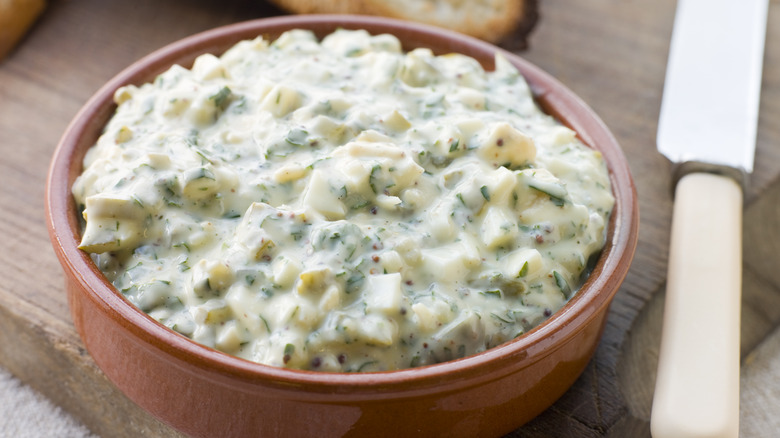What Is Sauce Gribiche And What Can You Use It For?
Sauce gribiche, pronounced "grib-eesh," is an egg-based sauce akin to its distant relatives, hollandaise and mayonnaise. Served cold or at room temperature, it typically accompanies fish, chicken, or other meats or tops roasted or steamed seasonal vegetables. Native to France, sauce gribiche has two variations, one that calls for the use of hard-boiled eggs and the other for soft-boiled eggs. However, the first version is considered to be the more classic and the one Auguste Escoffier detailed in his prestigious 1903 tome, "Le Guide Culinaire." Building upon the work of his predecessor, Marie Antoine-Carême, Escoffier is credited for documenting classical French haute-cuisine and for introducing his brigade system of kitchen management to the world.
Sauce gribiche has a few simple ingredients, starting with hard-boiled egg yolks whipped with Dijon mustard and oil to create an emulsification, then building upon that with a melody of chopped herbs, generally parsley, chervil, and tarragon, capers, and diced cornichons, or baby pickles. The addition of red or white wine vinegar give the sauce its classic vinaigrette-like tang, and the addition of oil, its mayonnaise-y consistency.
Unlike vinaigrette or mayonnaise, however, sauce gribiche's hallmark is the chunky pieces of egg whites and diced cornichons and capers that give it its "rustic" appearance. The second version calls for the use of soft-boiled eggs with the yolk whipped with mustard before adding the other ingredients, which include shallots and sometimes anchovies.
How to prepare sauce gribiche
To prepare sauce gribiche using the first method, boil two to four eggs for about 10 minutes, then transfer them directly to a prepared ice bath. After the eggs have cooled, peel and discard the shells. Separate the yolks from the whites and place in a mixing bowl. Set aside the whites. To make the emulsification, mash the yolks with a fork or whisk, then add the Dijon mustard according to the recipe. Whisk both ingredients together and add the vinegar. Using a neutral oil (traditionally canola, sunflower, or grapeseed), slowly drizzle it into the mixture, whisking constantly to create an emulsification. To thicken the sauce, add more oil. Finally, whisk in the capers, diced cornichons, and fresh herbs. Season with salt and pepper. Serve at room temperature or slightly chilled.
For a thinner sauce, use the second method which incorporates a 4-minute egg. Poach an egg in boiling water for four minutes, then transfer to an ice bath. When it is cool enough to handle, peel the egg and add it to a bowl. Add the mustard and break the egg with broad strokes using a whisk. The runny yolk will start to mix with the mustard, whereas the white will break up into pieces, which gives the sauce its chunky texture.
Next, add the oil in very slowly to create the emulsion. Once incorporated, a sauce-like consistency will emerge. Add your additional ingredients and stir. Top-season to taste, and serve.
How to serve sauce gribiche
Typically served alongside traditional French dishes such as tête de veau (calf's head) or over asparagus, sauce gribiche is anything but a one-trick pony. This versatile sauce pairs well with cold or hot fish dishes (think spooned over grilled salmon or drizzled over anchovies), cured meats, and roasted or steamed vegetables. (That includes the aforementioned asparagus, as well as other cruciferous vegetables, such as broccoli and cauliflower.) Sauce gribiche is often thought of as a precursor to tartar sauce, and its voluptuousness using the hard-boiled egg preparations lends well for it to be enjoyed as a spread on bread or mixed in with potatoes for a spin on a classic potato salad.
Once you've mastered the essence of sauce gribiche, you can let your creativity run wild and substitute ingredients as you please. Some common variations include the addition of green olives and different styles of pickles.
For pairing ideas to enjoy alongside homemade sauce gribiche, try this sautéed asparagus recipe or this roasted broccoli recipe.


